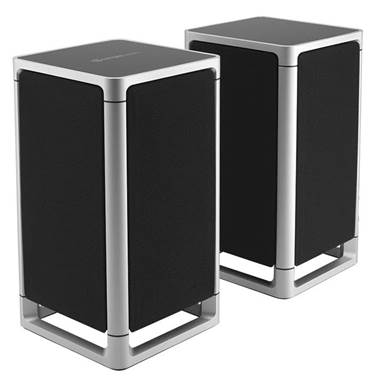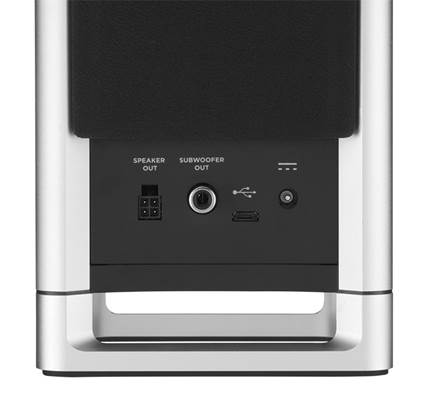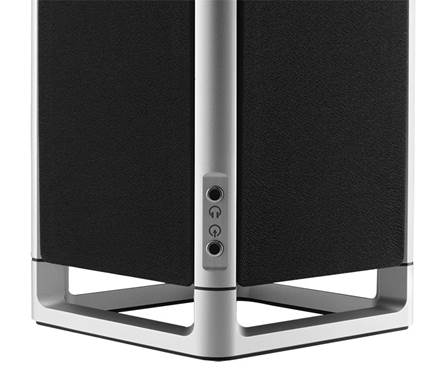Set up in 2008 by Peter Murphy, a former MD of Linn, the
Glasgow-based Simple Audio has so far concentrated on multi-room audio,
competing with Sonos rather than the high-end sector in which Linn operates.
Its portfolio currently comprises two models, a portable Bluetooth speaker, the
Simple Audio Go and this desktop model, the Listen. Priced at $657 it is
certainly a premium product for a desktop speaker, competing directly with the
likes of Bowers & Wilkins’ MM-1.

Simple Audio
Listen desktop speakers
The Listen stands out among desktop speakers in terms of its
features with a touch-sensitive control panel, subwoofer line-out and versatile
connectivity options that add Bluetooth wireless streaming to the regular 3.5mm
line-in and USB input. As you’d expect it’s compatible with the aptX codec,
which kicks in automatically if the source offers it.
Stop, look and Listen
Reasonably sized for desktop placement, the Listen seems
built for performance and is not exactly subtle looking. The industrial design
is intended to evoke the look of traditional audiophile speakers on stands.
Featuring icons for power, mute, source selection, Bluetooth pairing and a volume
control, it’s nice to use, requiring just the right amount of pressure to
change settings. A pebble-like IR remote control is also supplied.
The right speaker features a headphone jack and an aux input
on the front edge, with the rear accommodating the subwoofer out, micro USB
input, DC power input and the proprietary connection for the passive left
speaker. Simple Audio hasn’t been mean on cable quality or length, the USB
cable is 1.8m and an equally long extension speaker cable is provided, enabling
the Listen to be used in rooms where you want more distance between the
cabinets.
The speakers’ higher-end credentials are established by the
use of a bi-amplified design with separately powered tweeters and mids,
complemented by bass-reinforcing pressure drivers. They feature a 3in midrange
driver with neodymium magnets and a 1in silk-dome, ferrofluid-cooled tweeter.

Connectors of Simple
Audio Listen desktop speakers
Each active driver is discretely powered to maximize
bandwidth and to accommodate fine-tuned, phase-compensated, DSP-based active
crossovers. The Listen boasts studio-quality digital crossovers using a DSP,
which is an integral part of the digital signal path. These digital crossovers
use band pass filters that are precisely tuned to suit the acoustic response of
the drivers, and are phase aligned to help reduce or eliminate phase and/or
frequency distortion. Intelligent, dynamic compression is used to manage signal
levels to the woofer so that at very high volume levels clipping and/or distortion
are minimized. All in all, there’s a heck of a lot of engineering and design
gone in to the Listen.
The Listen doesn’t have an asynchronous USB input, so when
using the USB connection it extracts audio from your computer’s own soundcard.
In the case of an iMac, the rousing trumpet, whistle and strings in John
Williams’ theme tune to Raiders Of The Lost Ark highlight the remarkable level
of detail to be heard from the tweeters, which are bright, energetic and have
excellent timing.
Stereo imaging is satisfyingly broad and overall you feel
pleasantly immersed in the piece. There is, however, less control with the bass
response with the cabinets vibrating aggressively. Switching to another movie
soundtrack Jaws almost sees the speakers scuttling off the desk top, especially
when the two-note signature kicks in for the second time. Silent Shout by The
Knife happily proves a more sanguine experience, and is well within the
capabilities of the pressure drivers. However, there’s a slight opaqueness to
the midrange, which is much clearer on the B&W MM-1.
Listen without prejudice
Spitfire by Public Service Broadcasting is a reasonable,
well-balanced listen, but it just doesn’t have the punch of the MM-1. The extra
headroom and clarity afforded by hi-res audio music is also a little lost, the
longer double bass notes in Pete Alderton’s Soul Of A Man for example tailing
off quickly, giving the vocals a little too much emphasis.

Headphones jack of
Simple Audio Listen desktop speakers
Its bass and midrange performance is perhaps not as well
judged as its truly impressive tweeter, but overall the Listen is a well built
speaker that’s fun to use, and is a big improvement on any computer’s internal
sonic performance, and many TV speakers.
|
Specifications
·
Price: $657
·
Dimensions: 11 x 11 x 20 cm
·
Power: AC adapter with interchangeable power cord 12V DC input
via barrel connector
·
USB connection for Windows PCs and Apple OS X Macs
·
3.5mm stereo line-in and headphone output
·
40W per channel class-D amplifier
·
Fully integrated digital signal processor (DSP) and digital
signal path
·
1-inch ferro-fluid silk dome tweeter
·
3-inch long throw woofer with neodymium magnets
·
Bluetooth for Apple® iOSTM and AndroidTM-based
smartphones and tablets, or any Bluetooth A2DP-enabled device
|